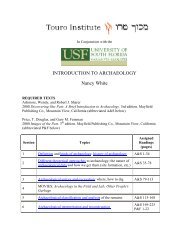In Conjunction with Cultural Anthropology - Touro Institute
In Conjunction with Cultural Anthropology - Touro Institute
In Conjunction with Cultural Anthropology - Touro Institute
You also want an ePaper? Increase the reach of your titles
YUMPU automatically turns print PDFs into web optimized ePapers that Google loves.
1. Husbands and wives do not share a common residence in some of the<br />
societies anthropologists have studied.<br />
2. Sexual fidelity is always a cultural expectation in marriage.<br />
3. More societies require marital fidelity of wives than do of husbands.<br />
4. Monogamy is the preferred form of marriage in most of the societies that<br />
anthropologists have studied.<br />
5. The Nayar of southern <strong>In</strong>dia placed no restrictions on a woman’s sexual<br />
freedoms.<br />
6. Sororal polygyny is typically viewed as one way a man demonstrates his<br />
success.<br />
7. Male-stratified polygyny is associated <strong>with</strong> subsistence economies in which<br />
male labor is the major source of income.<br />
8. Group marriages are uncommon where polyandry is preferred.<br />
9. Repeated cross-cousin marriage over generations reinforces economic and<br />
political ties among in-law families.<br />
10. The primary economic function of the North American family is<br />
consumption.<br />
Short Essay Questions - Chapter 10: Marriage, Family, and Household<br />
1. Why is it difficult to define marriage in any simple way that would include the Nayar of <strong>In</strong>dia<br />
as a group that has marriages?<br />
2. Under what conditions is sororal polygyny the common form of polygyny?<br />
3. <strong>In</strong> what kinds of environments might polyandry be advantageous?<br />
4. What was the social benefit of co marriage among the northern Alaskan <strong>In</strong>uit?<br />
5. What is meant by atypical marriage types?<br />
6. What benefit might fictive marriages have in a society in which kinship is the major economic<br />
and political institution?<br />
7. Describe the economic benefits that woman marriage has for the Nuer.<br />
8. What are the four main historical types of theories that have attempted to explain the<br />
universality or near universality of the incest taboo.<br />
9. How does the dowry differ from the indirect dowry?<br />
10. How does the household differ from the family?<br />
Reading Assignment: Chapter 11: Politics and Culture
















